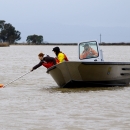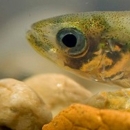Delta Smelt Supplementation
The San Francisco Bay-Delta and Lodi Fish and Wildlife offices and our partners are working on a plan to begin releasing hatchery-raised Delta smelt by 2024 to bolster the threatened fish's wild population.
Our biologists are collaborating with other federal and state agencies, the University of California, Davis, and other stakeholders on research projects to support supplementation. These projects include developing a spawning strategy that will enable us to understand how well our supplementation efforts are working.
Supplementation of Delta smelt back into the Delta is slated to begin by 2024 under terms of the 2019 biological opinion on the long-term operations of the federal Central Valley Project and the California State Water Project.
One big step in support of supplementation by 2024 is experimental releases of relatively small numbers of hatchery-raised Delta smelt into the wild, which began in December 2021. This will increase our knowledge about how best to carry out the releases logistically and will help us make any needed modifications to our plans before attempting larger releases.
Monitoring the effectiveness of our experimental releases and later supplementation efforts will involve the Bay-Delta and Lodi fish and wildlife offices and other partners. Monitoring efforts will include attempts to recapture some marked fish to estimate their survival rate, and will evaluate different kinds of tags and several high-tech uses of genetic information to help determine which fish survive and if they successfully reproduce in the wild.
These contributions to Delta smelt supplementation are further supported by groundbreaking research on genetics modeling and a suite of supplementation-centered research projects to fill critical knowledge gaps about the biology and ecology of Delta smelt.





